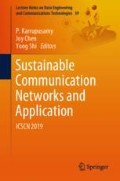Abstract
From past decades, LinkedIn appears as the professional connection site for both the freelancers and the recruiters. LinkedIn users are ought to post jobs, connect different industries and updates the people with current events. The goal of the paper is to create a report on the structure of the Organization to provide a smooth and efficient reporting hierarchy which involves data Analytics on the LinkedIn Data. So it is required to create an organizational hierarchy. Web Scraping is performed on the LinkedIn site for this intended purpose.
Access this chapter
Tax calculation will be finalised at checkout
Purchases are for personal use only
References
Glez, D., et al.: Web scraping technologies in API world. Brief. Bioinform. 15(5), 788–797 (2014)
Vargiu, E., Urru, M.: Exploiting web scraping in a collaborative filtering based approach to web advertising. Artif. Intell. Res. 2(1), 44–54 (2013)
Cowan, G.: Statistical Data Analysis. Oxford university press, Oxford (1998)
Mitchell, R.: Web Scraping with Python
Armano, G., Vargiu, E.: A unifying view of contextual advertising and recommender systems. In: Proceedings of International Conference on Knowledge Discovery and Information Retrieval, pp. 463–466 (2010)
Koolen, M., Kamps, J.: Are semantically related links more effective for retrieval? In: Proceedings of the 33rd European Conference on Advances in Information Retrieval, pp. 92–103. Springer, Heidelberg (2011)
Anagnostopoulos, A., Broder, A.Z., Gabrilovich, E., Josifovski, V., Riedel, L.: Just-in-time contextual advertising. In: Proceedings of the Sixteenth ACM Conference on Conference on Information and Knowledge Management, pp. 331–340. ACM, New York (2007)
Lacerda, A., Cristo, M., Gonçalves, M.A., Fan, W., Ziviani, N., Ribeiro-Neto, B.: Learning to advertise. In: Proceedings of the 29th Annual International ACM SIGIR Conference on Research and Development in Information Retrieval, pp. 549–556. ACM, New York (2006)
Berry, M.W.: Survey of Text Mining. Springer, New York (2003)
Adams, A., McCrindle, R.: Pandora’s Box: Social and Professional Issues of the Information Age. Wiley, Hoboken (2008)
Author information
Authors and Affiliations
Corresponding author
Editor information
Editors and Affiliations
Rights and permissions
Copyright information
© 2020 Springer Nature Switzerland AG
About this paper
Cite this paper
Mathur, S., Sharma, S. (2020). To Scrap the LinkedIn Data to Create the Organization’s Team Chart. In: Karrupusamy, P., Chen, J., Shi, Y. (eds) Sustainable Communication Networks and Application. ICSCN 2019. Lecture Notes on Data Engineering and Communications Technologies, vol 39. Springer, Cham. https://doi.org/10.1007/978-3-030-34515-0_29
Download citation
DOI: https://doi.org/10.1007/978-3-030-34515-0_29
Published:
Publisher Name: Springer, Cham
Print ISBN: 978-3-030-34514-3
Online ISBN: 978-3-030-34515-0
eBook Packages: Intelligent Technologies and RoboticsIntelligent Technologies and Robotics (R0)

